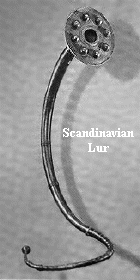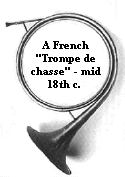 |
A Brief History of Horn Evolution

|
1. Origins
Instruments made from animal horns have existed since ancient times - they were
primarily used as signaling devices. The horn as a musical instrument has only existed for
several hundred years.
One of the earliest "horn-like" instruments, the lur, dates back to sixth
century B.C. Made of bronze, these horns were used on the battlefields by Scandinavian
clans. It makes a loud, obnoxious sound, just perfect for striking terror into the
enemy camp.
|

|
In Europe, horns gained popularity in the trendy sport of
hunting. As this aristocratic sport spread, horn-makers experimented with different shapes
and sizes to increase the range of notes possible. In 1636, French musical scholar
Marin Mersenne wrote of four different kinds of horns in his Harmonie Universelle: Le
grand cor (the big horn), the cor ŕ plusiers tours, (the horn of several
turns), le cor qui n'a qu'un seul tour (the horn which has only one turn), and le
huchet (the horn with which one calls from afar). Horns such as the cor de chasse and
trompe de chasse (pictured left) fall into this latter category. |
Shortly thereafter, the horn began to appear in the concert halls and theaters.
Too raucous for inclusion with the fine oboes and violins in the orchestra pit though, at
first the hunting horns were used only onstage in scenes depicting, naturally, the hunt.
The horn at this point was not yet ready for serious artistic endeavors - only as
"special effects," to give flashy theatrics to stage productions.
Meanwhile in Bohemia, Austria and Germany a more refined school of horn playing was
developing under the auspices of Count Franz Anton von Sporck. The gentleman Count
was, for all of his life, a hunting aficionado. He even founded The Order of St. Hubert
(the patron saint of the hunt). Then while visiting France in the 1680's, Count von
Sporck heard some cors de chasse at a hunt. Immediately after hearing the French
hunting horns, von Sporck instructed that two men of his consort be taught to play the
instrument. These two men, Wenzel Sweda and Peter Röllig became the source from which
horn playing in all of Bohemia and Germany grew.
 CONTINUE... CONTINUE...
This is hornplanet.com
HOME
|| HornPage | St. Louis Brass | Opus 90 | Bacon | Golden Horn
|
Store | Food
|| CONTACT
 |
Copyright © Thomas Bacon
1996 - 2009
All rights reserved |
Site Design by Horndog
www.horndoggie.com |

|
|